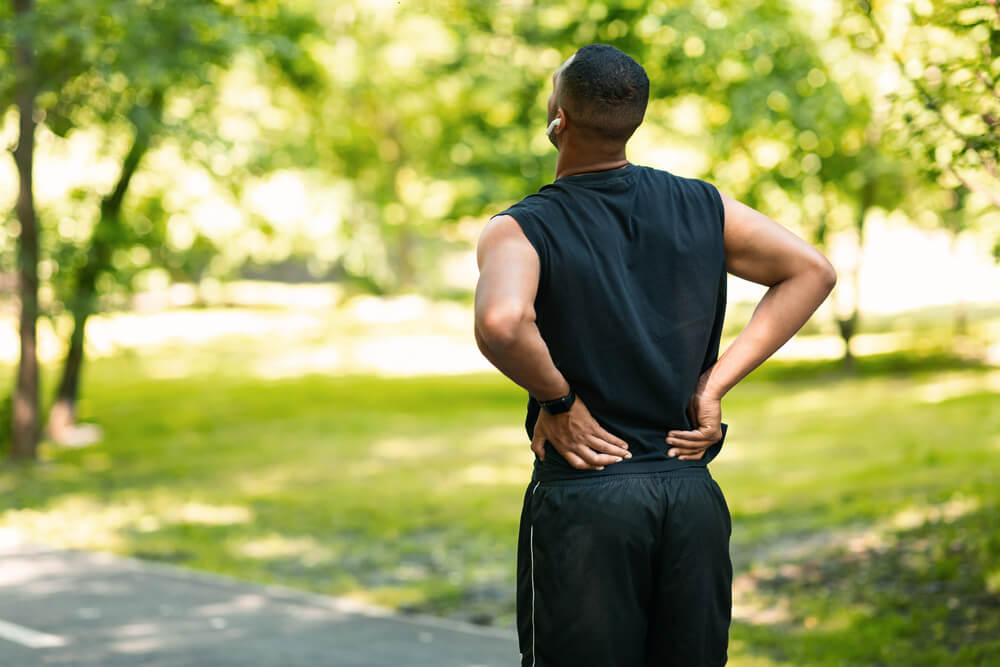Up to 500,000 Americans are currently living with spinal stenosis, a condition in which the spaces between the vertebrae narrow and compress major nerves. For most people, symptoms develop slowly. Some people may not experience any symptoms at all. Others, however, experience continuous pain and discomfort. These and other symptoms may only worsen if you’re doing the wrong exercises.
What are symptoms of spinal stenosis?
Spinal stenosis is most often found in the lower back and neck. Those who have it in their back may experience the following symptoms:
- Lower back pain and sciatica.
- Weakness in the legs and feet.
- Pain that spreads down the legs and worsens when standing.
- Numbness, tingling, or cramping in the legs and feet.
Since spinal stenosis can also affect the neck, it can lead to:
- Neck pain.
- Weakness in the hand, arm, or fingers.
- Numbness or tingling that spreads down the arms.
Depending on the severity of the condition, each type of spinal stenosis can lead to different symptoms that need a particular treatment. Physical therapists can show you exercises and stretches that can treat your unique spinal stenosis symptoms. They can also help you learn which exercises you should avoid when you have spinal stenosis.
What causes spinal stenosis?
Spinal stenosis is often an age-related condition in which the spine degenerates as the body gets older. As a result, it is most common in men and women over 50 years old.
Osteoarthritis, in which the cartilage between joints and vertebrae breaks down over time, can cause the spine to compress and irritate nearby nerves. In addition, discs in your spine can degenerate and flatten as you age, leading to disc herniation. Both arthritis and disc herniation can shorten the spine and pinch nerves along the spinal cord, leading to spinal stenosis.
People with spinal stenosis should avoid these types of exercises
Getting your body moving can be helpful for many types of pain, and the pain of spinal stenosis is no exception. One of the main ways physical therapists treat this condition is with exercises like core strengthening, which can serve to support your spine.
However, there are some exercises that your physical therapist may encourage you to avoid if you have spinal stenosis. This is because some exercises can further irritate your vertebrae, your spinal cord and your back.
The following exercises may worsen spinal stenosis-related symptoms over time:
- Extension stretches — Generally, stretches that release tension from muscles in your lower back can improve mobility. However, with spinal stenosis, doing so can cause the back sides of each vertebra to move closer together. This can cause the spine’s nerve pathways to narrow even more, leading to even more nerve compression and pain. For this reason, your physical therapist may ask you not to do exercises like the:
- Cobra stretch.
- Piriformis stretch.
- Standing extension stretch.
It is important to speak to your physical therapist before you try any stretches that target your back or neck. This way, they can be sure that you are limiting your risk of further injury by following a safe at-home routine.
- Running — Running is a popular cardio exercise. However, it is also a high-impact activity. High-impact exercises can place immense stress on your body and irritate your joints. Adding stress to your spine can make the symptoms of spinal stenosis worse and increase your risk of further injury. This is especially true since spinal stenosis can affect your gait and balance.
If you would like to increase your cardio while protecting your spine, you can walk quickly instead and increase your distance gradually. You could also try low-impact cardio options like swimming, in which water protects your joints from shock and impact.
- Lower back exercises — Building strength in your lower back can help relieve spinal stenosis symptoms. In fact, stronger back muscles can better support your spine, easing pressure on compressed nerves.
However, some strengthening exercises won’t likely offer these benefits when you have spinal stenosis. In fact, some exercises can worsen spinal stenosis symptoms. This is especially true if they involve lower back extension. Your physical therapist may tell you to avoid back strengthening exercises like the: - Glute bridge.
- Superman.
- Cat-cow exercise.
Find out more about exercises you should avoid with spinal stenosis at SSOR
Want to make sure you’re avoiding exercises that can worsen your spinal stenosis symptoms? Our SSOR team can help you with this goal, and we can also help you reduce and prevent your symptoms. Our physical therapists can do a free screening of your back to learn how spinal stenosis is affecting you. Then, we can create a personalized therapy plan for you that’s designed to reduce symptoms and prevent future flare-ups.
Don’t have time to come to an in-person appointment? Our team can save you some time with our at-home care and virtual therapy services. We can even help you treat your spinal stenosis if you don’t have a referral from your doctor.
Contact us today for more information about our spinal stenosis treatment options or to schedule an initial appointment.

